When it comes to fishing, there is no shortage of slang, nicknames, and strange terminology used to describe the pursuit of catching a fish.
In this article, I cover 185 of the most common (and some strange) freshwater fishing terms that every angler should know.
They’re listed in alphabetical order for easy reference, enjoy!
Freshwater Fishing Terms
- Alabama Rig: An artificial rig comprised of 3 or more hooks designed to look like a school of baitfish used when targeting bass.
- Alligator gar: A large and powerful predatory fish species found in freshwater rivers and lakes.
- Anchor buoy: A buoy attached to an anchor to mark its location on the water’s surface.
- Artificial fly: A type of fishing lure made with feathers, fur, and other materials to imitate insects or baitfish.
- Backwater: A calm or slow-moving section of a river or stream that branches off from the main flow.
- Bag limit: The maximum number of fish that an angler is allowed to keep in one day.
- Bass boat: A specialized boat designed for bass fishing, equipped with features to enhance angler efficiency.
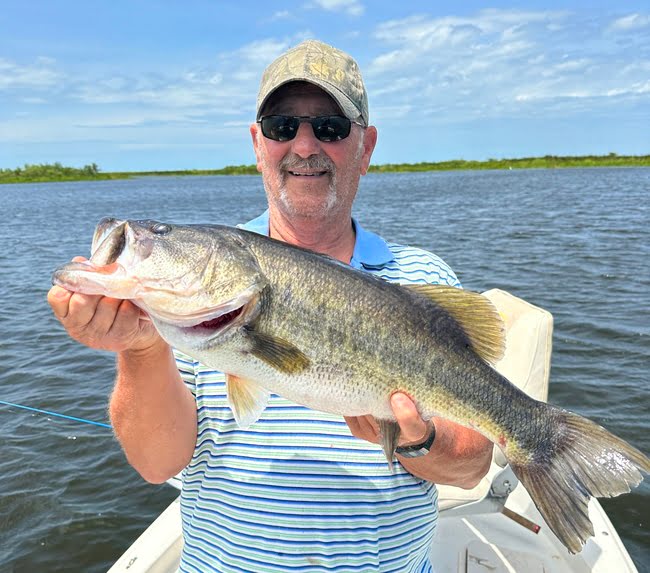
- Bedding: The process of fish creating a nest or bed in shallow waters during spawning season.
- BFS: Bait Finesse System, a term for a new style of fishing featuring ultralight baitcasting reels and rods for lures weighing 1/8 ounce or less.
- Biggin’: Slang term for a large or trophy-sized fish.
- Birdsnest: A jumbled or tangled mess of fishing line, common with baitcasting reels.
- Blue catfish: A species of catfish known for its blue-gray coloration and whisker-like barbels.
- Bluegill: A small, colorful freshwater sunfish species, popular among beginners and young anglers.
- Boilie: A round, boiled bait typically used in carp fishing.
- Bonefish: A highly sought-after saltwater game fish, also known as the “grey ghost.”
- Bottom Feeder: A slang term usually referring to catfish or carp, both known to feed along the bottom.
- Braid fishing line: A type of fishing line made from multiple strands of synthetic fiber, known for its strength and low stretch.
- Bucketmouth: Slang term for a largemouth bass, referring to its large mouth.
- Bumpboard: A measuring device used to quickly and efficiently take the length measurement of a fish. Often used in Kayak bass tournaments.
- Carolina rig: A fishing rig with a sliding weight above a swivel and hook, used to present bait on the bottom.
- Carpocalypse: A humorous term used to describe a day of successful carp fishing, catching a significant number of carp.
- Catfish rod: A sturdy and powerful fishing rod designed specifically for catching catfish.
- Cattin’: Slang term for catfishing.
- Chatterbait: A type of fishing lure with a vibrating jig head, known for its unique fish-attracting action.
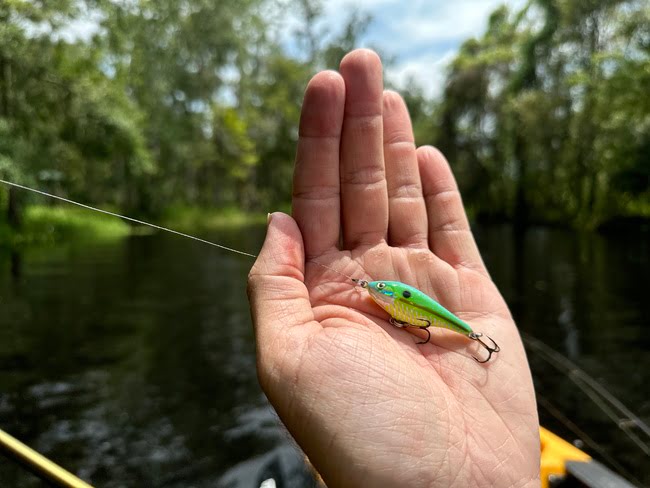
- Chod rig: A specialized carp fishing rig designed to present bait on soft, silty bottoms.
- Chum bucket: A container filled with bait or fish attractants used to create chum in the water.
- Circle Hook: Specially designed fishing hooks with a curved point to reduce the chances of a fish swallowing the bait.
- Coppernose: A subspecies of the bluegill, native to the Southeastern United States. Known for the distinctive copper band across the forehead.
- Corking: A method used to catch fish, especially catfish, by placing bait in a plastic or metal tube with holes, allowing scent to attract fish.
- Crank ’em down: Retrieving a crankbait close to the bottom to entice fish.
- Crankbait: A fishing lure with a diving lip that creates a swimming motion when retrieved.
- Crappie Hole: A term used to describe a hotspot or concentration of crappie in a small defined area.
- Crappie Tree: An artificial fish attraction device secured to the bottom of a lake or pond, usually constructed of PVC to attract crappie.
- Dapper: A type of fishing lure that imitates small fish, with a darting action in the water.
- Deadstick: A fishing technique where the bait is left motionless in the water to attract fish.
- Dink: A small or undersized fish caught by an angler.
- Dink city: Slang term for an area with an abundance of small fish, especially crappie or small bass.
- Dinker: A term used for a small fish, typically used as live bait for larger fish.
- Dipping: A fishing technique where the angler uses a dip net to catch fish, often used in ice fishing.
- DNR (Department of Natural Resources): Government agency responsible for managing wildlife and natural resources, including fishing regulations.
- Dumper: Slang term for a fish that takes the bait aggressively and runs fast after being hooked.
- Egg sinker: A type of fishing weight shaped like an egg, used to sink the bait to the desired depth.
- Eddy: A circular current or whirlpool in a river or stream.
- Fatty: Slang term for a well-fed, plump fish.
- Finesse fishing: A fishing technique that involves using subtle and delicate presentations to entice cautious fish.
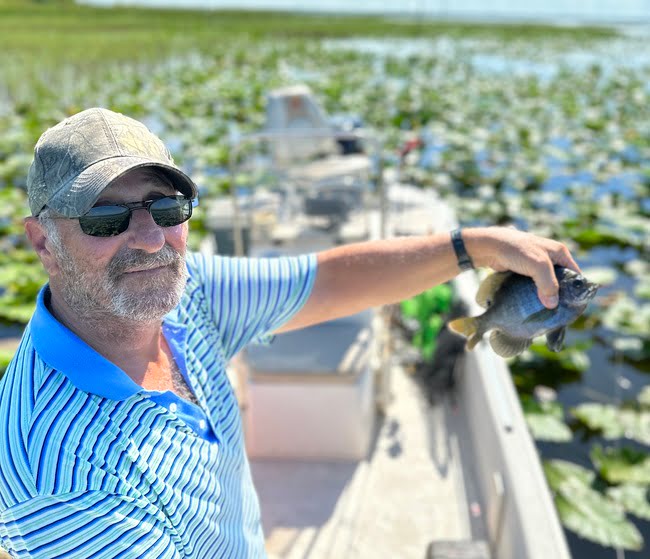
- Finicky: Used to describe fish that are being particularly selective or hesitant to take the bait.
- Fishfinder: An electronic device that uses sonar technology to locate fish and underwater structures.
- Fish Stringer: A rope or chain device used by anglers to compile and transport fish they intend to keep.
- Flipping jig: A type of fishing jig designed for precise and silent presentations.
- Flipping stick: A specialized fishing rod used for flipping and pitching techniques.
- Float tube: A personal flotation device that allows anglers to fish while sitting partially submerged in the water.
- Floating minnow: A type of fishing lure that floats on the water’s surface when not in motion.
- Flutter spoon: A fishing lure with a thin, concave body that flutters and wobbles when retrieved.
- Fly fishing: A method of fishing using artificial flies made of feathers, fur, and other materials to imitate insects or baitfish.
- Freeline: Fishing with live bait or a lure without any additional weights or floats.
- Freshwater drum: A fish species found in freshwater rivers and lakes, known for its drumming sound.
- Flogger: A device used to view fish and their behavior underwater, typically used in ice fishing.
- Football jig: A type of jig with a football-shaped head, designed for fishing in rocky areas.
- Frogging: A fishing technique using frog-shaped lures, often for bass fishing in weedy areas.
- Fry: Newly hatched fish in their early developmental stage.
- Gaff: A long pole with a hook at the end, used to land large fish or haul them aboard a boat.
- Game warden: A law enforcement officer responsible for enforcing fishing and wildlife regulations.
- Gill plates: The protective bony covers over a fish’s gills.
- Glass: Slang term for a fiberglass fishing rod, known for its flexibility and sensitivity.
- Grind: The determination to continue fishing despite challenging conditions or lack of success.
- Grub: A soft plastic bait with a short, curved body, often used for panfishing.
- Gum ball: A term for a very small fish, often used as live bait for larger fish.
- Hellgrammite: The larval stage of the dobsonfly, often used as bait for fish.
- High-sticking: Holding the fishing rod high while fighting a fish, increasing the risk of breaking the rod.
- High Vis Line: High Visibility fishing line that is often colored yellow or green so it’s easy to see in a variety of conditions.
- Hybrids: Crossbred fish species, often referring to a cross between two different bass species or panfish species.
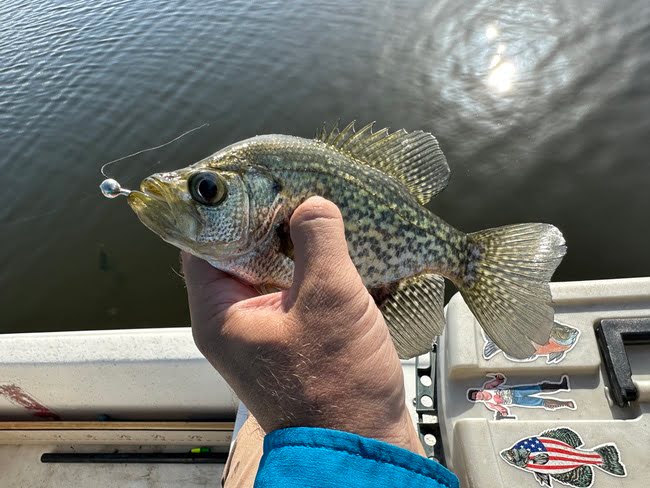
- Hydrology: The study of water and its movement in rivers, lakes, and other bodies of water.
- Ice auger: A tool used to create holes in ice for ice fishing.
- In-line spinner: A type of fishing lure with a spinning blade directly in line with the fishing line.
- Jig: A versatile fishing lure consisting of a hook with a lead weight molded around it.
- Jig head: A weighted hook used with soft plastic baits to make them sink and move attractively in the water.
- Jug fishing: A fishing method where baited lines are attached to floating jugs or bottles to catch fish.
- Kickin’ their lips: Slang term for when fish aggressively strike at lures or baits.
- Koi-Fish: Ornamental carp fish often used seen in ponds and gardens.
- Kool-Aid Bait: Catfish or carp baits mixed with powdered Kool-Aid to increase the scent and effectiveness.
- Kype: A hooked or curved lower jaw of male salmon or trout during the breeding season.
- Largemouth bass: A popular freshwater game fish known for its aggressive strikes and large mouth.
- Lip gripper: A tool used to safely handle and lift a fish by its lower jaw.
- Lipless crankbait: A type of crankbait without a diving lip, often used in shallow waters.
- Livescope: Forward-facing sonar used to display fish on electronic imaging devices in real-time.
- Live well: A compartment in a boat used to hold live fish for later release.
- Longline fishing: A fishing technique that uses a long mainline with multiple baited hooks.
- Lunker: Slang term for a big or heavyweight fish.
- Magic hour: The period of time around sunrise or sunset, known for increased fish activity.
- Match fishing: A competitive style of fishing where anglers aim to catch the most weight of fish within a set time frame.
- Match rod and reel: Specialized fishing gear designed for match fishing, typically a long rod and fixed-spool reel.
- Meat fishing: A term used to describe fishing with the intention of catching fish for consumption.
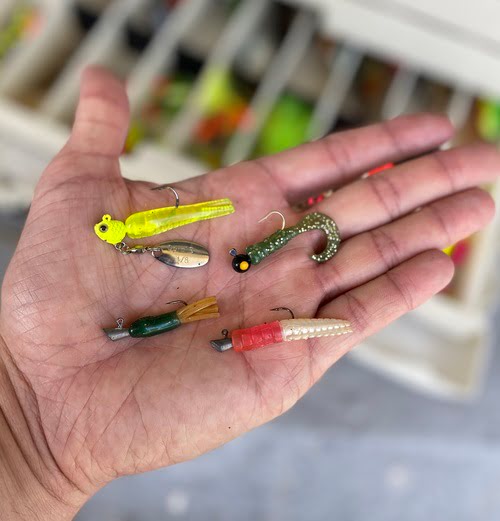
- Meanmouth Bass: A rare hybrid species of bass from a largemouth and smallmouth bass.
- Micro Fishing: The sport of using extremely small hooks to catch tiny fish usually less than 3 inches in length.
- Minnow trap: A device used to catch live minnows for use as bait.
- Mojo Rig: A variation of the Carolina Rig, a heavy weight is secured with bobber stops 12″-18″ above your lure.
- Monofilament memory: The tendency of monofilament fishing line to retain its coiled shape after being wound on a spool.
- Muck boots: Waterproof boots used by anglers when fishing in muddy or marshy areas.
- Nibble-n-nap: When the fish are not actively biting, and an angler takes a break or dozes off while waiting for a bite.
- Noodling: A hand-fishing technique where anglers use their hands to catch catfish in their underwater nests.
- Nymph fly: An artificial fly designed to imitate the nymph stage of aquatic insects.
- On the board: The first fish caught on a fishing trip.
- Outfit: The combination of fishing rod, reel, line, and tackle used for a specific fishing style.
- Outriggers: Extendable poles used on boats to spread fishing lines over a wider area.
- Paddlefish: Also known as a spoonbill, a riverine fish native to north america known for their elongated snout.
- Paddle tail: A soft plastic bait with a tail designed to mimic the movement of a swimming fish.
- Paddletail swimbait: A type of soft plastic lure with a paddle-shaped tail, creating a realistic swimming action.
- Pad cracker: A topwater lure designed to make a loud popping sound when retrieved.
- Palomar knot: A popular fishing knot used to secure a hook or lure to the fishing line.
- Palomino Trout: A Golden Rainbow trout, known for its bright colors.
- Panfish: Term used to describe small freshwater fish, that could fit into a cooking pan. Typically referred to sunfish species and small trout.
- Peacock bass: A colorful and aggressive freshwater fish species often found in South America.
- Pec fin: Slang term for the pectoral fin of a fish.
- Perch jerker: A small, sensitive fishing rod used for panfishing, particularly perch.
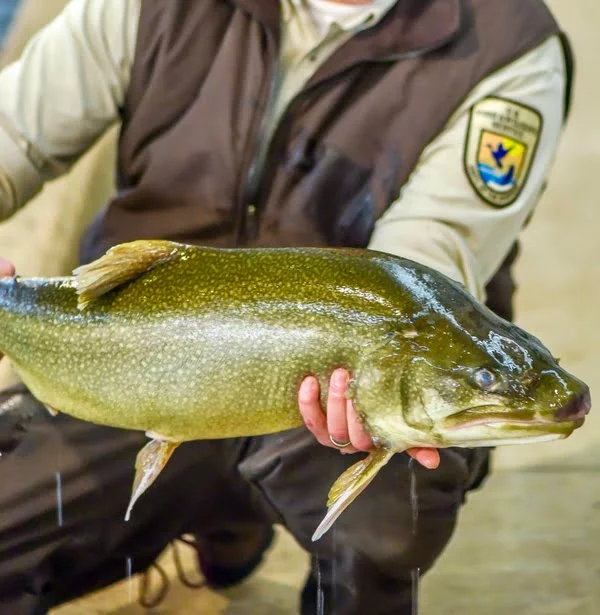
- Pick-up: The moment when a fish takes the bait and begins to swim away with it.
- Pie plate: Slang term for a large, heavy spinnerbait.
- Pogies: Slang term for small fish, often used as live bait for larger predatory fish.
- Pond hopping: Moving from one small fishing pond to another in search of fish.
- Popper: A topwater fishing lure designed to create a popping or splashing sound when retrieved.
- Powerbait: A brand of scented artificial bait designed to attract fish.
- Punch shot: A variation of the Texas rig used to fish through heavy vegetation.
- Quick limit: When an angler reaches the legal limit of fish they are allowed to keep in a short period.
- Quick release: Safely and promptly releasing a caught fish back into the water.
- Quiet as a shadow: A phrase used to describe the stealthy approach of an angler to avoid spooking fish.
- Release tool: A device used to safely remove hooks from the mouth of a caught fish.
- Rip and pause: A retrieval technique where the angler quickly jerks the lure and then pauses, mimicking an injured fish’s movements.
- Riprap bass: Slang term for bass caught near riprap, the rocks lining the shoreline or dam.
- Rattletrap: A type of fishing lure with built-in rattles or noise-making devices.
- Redworm: A type of earthworm commonly used as fishing bait.
- Remote control bait boat: A small, motorized boat used to deliver bait to specific areas of a waterbody.
- Rig: The setup or arrangement of fishing tackle, bait, and line.
- Rock bass: A small but hard-fighting freshwater fish species.
- Rough Fish: A broad term applied to less desirable species of freshwater fish that do not offer sporting value.
- Scale pattern: The arrangement and coloration of scales on a fish, often used by anglers to identify different species.
- Sculpin: A small bottom-dwelling fish often used as bait for trout and other game fish.
- Senko: A very popular style of plastic worm made by the Gary Yamamoto Bait company. Popular with bass fishing and very versatile.
- Set the hook: The action of quickly pulling the rod upward to drive the hook into the fish’s mouth.
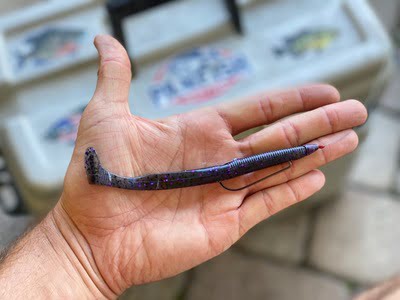
- Shakey head worm: A type of soft plastic worm rigged on a shakey head jig.
- Shad dart: A small, dart-shaped fishing lure used to catch shad and other small fish.
- Shaky rig: A fishing technique using a shaky head jig with a soft plastic worm.
- Single-hook spinnerbait: A spinnerbait with only one hook, used to minimize snags.
- Slop: Thick, matted vegetation on the water’s surface, attracting fish seeking shelter and food.
- Soap Bait: Catfish or carp bait made from ivory soap.
- Soft bait: A type of fishing lure made from soft and flexible materials, often imitating worms, grubs, or other prey.
- Speck: The nickname given to black crappie by anglers in Florida and South Georgia.
- Spey casting: A specialized fly casting technique used in salmon and steelhead fishing.
- Spinner rig: A fishing rig consisting of a spinner blade and a baited hook used for trolling.
- Spinnerbait: A fishing lure with one or more spinning blades and a rubber skirt, imitating baitfish.
- Spool: The cylindrical part of a fishing reel that holds the fishing line.
- Spawning run: The migration of fish to their spawning grounds.
- Stick and move: A fishing strategy involving quick moves to different spots in search of active fish.
- Stick float: A type of float used in coarse fishing to suspend bait at a specific depth in the water.
- Stickbait: A long, slender fishing lure designed to resemble a small fish or baitfish.
- Stinkbait: A highly scented bait used to attract catfish.
- Strike indicator: A small float or buoy used in fly fishing to signal when a fish strikes the bait.
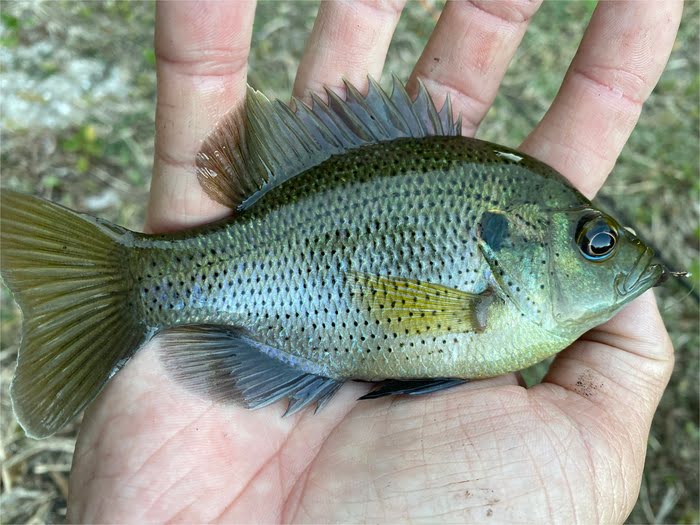
- Stumpknocker: The colloquial nickname for the spotted sunfish, a small species of panfish native to the Southeastern United States.
- Suspend: When a lure or bait remains at a particular depth in the water column without rising or sinking.
- Suspending jerkbait: A fishing lure designed to suspend in the water, often used in a jerking motion to imitate injured prey.
- Swimbait: A type of fishing lure designed to imitate the swimming action of a fish.
- Tail pinch: A technique used to immobilize a fish’s tail for easier measuring.
- Tail slap: The sound and splash created by a fish’s tail when it strikes the water surface.
- Take: The moment when a fish bites or strikes the bait or lure.
- Telescopic Fishing Rod: A collapsible fishing rod designed to fit into small spaces or used for travel.
- Terminal tackle: The hooks, swivels, weights, and other components attached to the end of the fishing line.
- Topwater: A term used for fishing lures or baits designed to float on the water’s surface.
- Topwater frog: A frog-shaped fishing lure used for topwater fishing, particularly for bass.
- Trout: A popular freshwater game fish species known for its colorful appearance and lively fight.
- Trophy hunting: Fishing with the primary goal of catching large, trophy-sized fish.
- Tube jig: A soft plastic bait shaped like a tube, often used with jig heads for bass fishing.
- Ultralight reel: A small and lightweight fishing reel designed for use with ultralight rods.
- Ultralight rod: A lightweight and sensitive fishing rod designed for use with light fishing lines.
- Underwater sonar camera: A device used to view and record underwater images and fish activity.
- Unhooking mat: A padded mat used to place fish on while removing hooks, protecting them from harm.
- Upstream: Fishing in the direction of the current in a river or stream.
- UV fishing lures: Fishing lures made with ultraviolet-reactive materials to increase visibility underwater.
- Vegetation line: The boundary between open water and dense underwater vegetation.
- Vintage gear: Refers to old or classic fishing tackle and equipment.
- Walk the dog: A retrieval technique for topwater lures that creates a zigzag or walking action.
- Warmwater species: Fish species that thrive in warmer freshwater environments.
- Weight forward line: A type of fly fishing line with the majority of its weight concentrated at the front end.
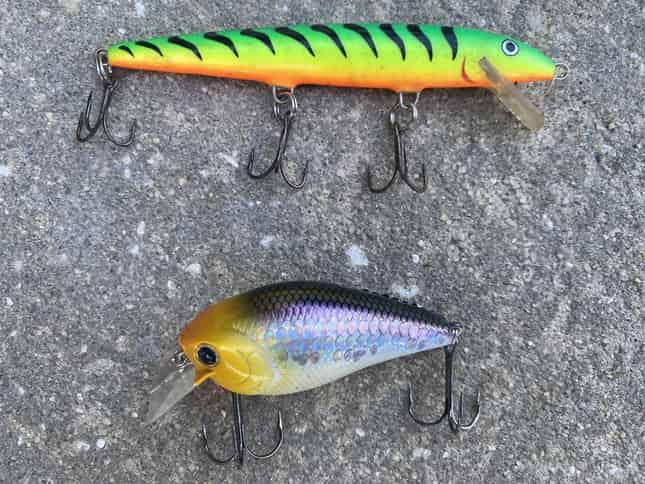
- Weightless worm: A soft plastic worm rigged without any additional weights to create a natural, slow-falling presentation.
- Whisker fish: Slang term for catfish, referring to their long, whisker-like barbels.
- Wicking stick: A term used to describe an exceptionally stiff and powerful fishing rod.
- X-factor: Refers to an unexpected and unusual event that leads to exceptional fishing success.
- X-factor bait: A bait or lure that is exceptionally effective in catching fish.
- X-tra strong hook: A fishing hook with increased strength, ideal for catching large or powerful fish.
- X-ray fluorocarbon line: A type of fishing line made from fluorocarbon material, known for its transparency underwater.
- Xylazine: A type of sedative used to immobilize fish temporarily for tagging or scientific research.
- Yankee jig: A type of fishing jig designed with a flat or concave head and a bucktail or soft plastic body.
- Yabby pump: A tool used to catch yabbies (crayfish) for use as fishing bait.
- Yo-yoing: A jigging fishing technique involving repeated up-and-down motions of the fishing lure often used to catch crappie.
- Yank ‘n crank: A fishing technique involving quick, forceful retrieves of a crankbait.
- Yellow perch: A freshwater fish species known for its yellow coloration and delicious taste.
- Yo-yo worm: A soft plastic worm used in a yo-yoing fishing technique.
- YOLO worm: Slang term for a big, flashy, and attention-grabbing worm used for bass
If you haven’t guessed yet, I love fishing and everything about it!
To learn more about why I started Panfish Nation, visit the About page and follow along on Social Media:


Download a copy of my FREE Lure Color Selection Chart & Knot Guide!
Stay up to date with fishing reports, tackle reviews, industry news, and much more! We respect your privacy, unsubscribe at any time.
